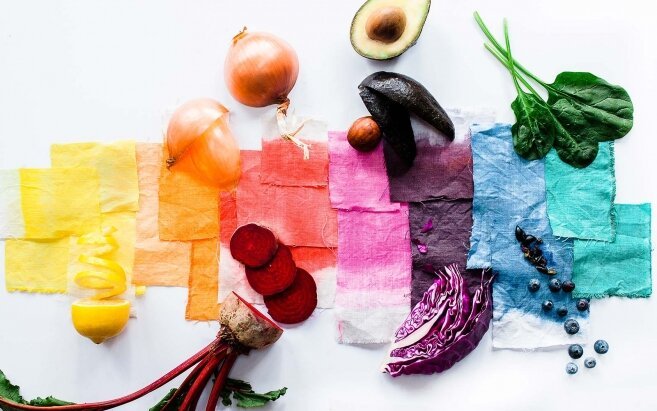Nature’s Dye: Plant Based Dye for Clothing
Did you know your supermarket is also a paint store? In food as in nature, color abounds. Natural dyes, made from food scraps that would otherwise be composted or thrown away, inspire innovative opportunities that reduce food waste. These dyes can take the place of synthetic chemical colorings in foods like frostings, batters, and icings. They can also dye fiber such as pillowcases, yarn, and clothing. Kalen Kaminski founded Upstate; a clothing line dyed with grocery-store staples. She described the process saying, “it captures the chaos, and it’s pretty beautiful actually.”
The possibilities are endless and the resources are right at your fingertips, or more precisely, right in your fridge.
There are two things to note before you begin: the first is that natural dyes stick best to natural fabrics. Cotton, wool, linen, and silk fall under this category because they are highly porous on a microscopic level. Secondly, don’t expect the color of your garment to come out exactly how you envisioned. Embrace the process, let the food scraps soak, and the colors will naturally produce. While the brightest ingredients (think turmeric, red cabbage, and beets) adhere to fabrics the best, anything can be used as a dye if you have enough of it. Don’t be afraid to play with patterns and fold the clothing accordingly.
NATURAL FOOD DYES 101
Natural food dyes create beautiful one-of-a-kind shades for clothing, fabric, and yarn. Here are the general steps for creating natural food dyes from food scraps:
“Gather at least one cup of leftover fruit and vegetable bits. Chop the fruits and veggies to allow more color to saturate the dye. Add the chopped food scraps to a saucepan and cover with twice as much water as the food quantity. For one cup of scraps, use two cups of water. Bring the water to a boil. Reduce heat and simmer for approximately one hour, or until the dye reaches the desired color. Turn off heat and let the water come to room temperature. Strain the cooled dye into a container (Edible LA).”
Once you have created the dye, it is time to prepare the fabric. Natural fibers require an extra step of preparation to hold natural dye. They need a fixative – also known as a mordant – to adhere to the colors to the clothing. In order to create long-lasting colored fabrics:
For fruit dyes, simmer fabric in ¼ cup salt and 4 cups water for approximately one hour.
For vegetable dyes, simmer fabric in 1 cup vinegar and 4 cups water for approximately one hour.
Once the hour is up, carefully rinse the fabric in cool water. Gently remove excess water from the fabric and immediately soak in the natural dye until it reaches the desired color. This could take anywhere from a couple of hours to a couple of days. Make sure to use separate pots, containers, and utensils for your dye projects. Place the dyed fabric in a container overnight. The following day, rinse the fabric under a faucet until the water runs clear. Hang to air dry, or, to further set the dye, run the garment through the dryer by itself.
Deciding the colors, you want and, therefore, which food scraps you need can be challenging. Here are some common food scraps and the colors they evoke
Creating natural food dyes rests on a willingness to experiment with ingredients to see what colors emerge. Thanks to nature’s natural properties, the creative possibilities are endless. Next time you’re at the supermarket, browse the produce and spice aisles to make your own plant-based palette. Or stop by your local Chipotle and ask for their discarded avocado skins and pits. Learn to embrace the mess because you never know what you’ll create until you try.
Strike Out,
Writer: Ellie Rill
Editor: Joey Flanagan
Tallahassee


